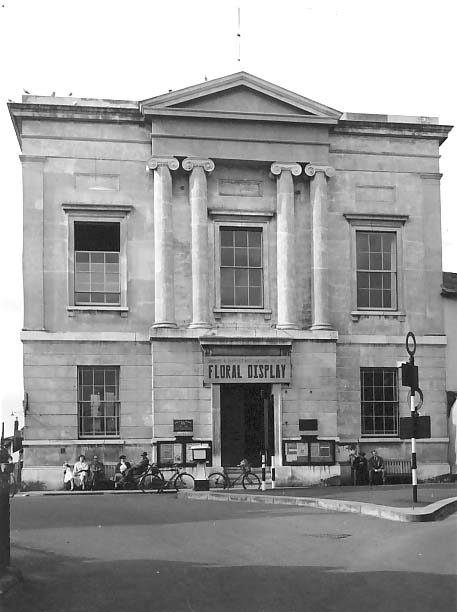Built by Thomas Ginn of Sudbury 1826/27 and opened for use in 1828. It is a fine and well-proportioned building in the Greek classic style occupying a prestigious site overlooking the Old Market Place.
Thomas Ginn was a builder and property developer at a time when Sudbury was going through a period of civic improvements for which a special Act of Parliament was passed in 1826 for … The Paving, Lighting, Cleansing, Watching, Watering and improving the Town and Borough of Sudbury in Suffolk.
Mr Thomas Ginn, lived in Borehamgate, was commissioned to build a new town hall in the fashionable Greek style on the site of The Exchequer Inn. He produced a most elegant building in white Ballingdon brick with a stuccoed front of three bays with a pedimented centre on a pair of coupled Ionic columns. In the pediment were the arms of the borough. There was a courtroom for the Quarterly Assizes and the Mayor’s Parlour on the ground floor. A central staircase hall led up to the Assembly Room that fills the
width of the building. At the rear the old and impressive entrance to the gaol, which held the prisoners overnight before the assizes, has been skilfully adapted to serve the modern extensions. The cost of the new town hall was a little over £2,000 and it was completed in 1829/30 (see below).
There is ample evidence proving that Ginn built the new Town Hall but the design is superior to what one would expect from a modest local builder and there has long been a suspicion that he employed an architect. No record of such an appointment appears in any of the old Borough records.
Architect’s Name Discovered (November 2008)
Mrs Sue Woodrow of Hailsham, East Sussex, contacted the Town Archivist who in turn referred her to the Chairman of Sudbury History Society (Barry Wall), with a request for information concerning an ancestor of hers, Andrew John Johnston.
He was born in 1772 Stitchel, Roxburghshire and in 1802 married Elizabeth Fairbairn. In 1805 he is described as a carpenter and two years later was working for Thomas Hardwick as Clerk of Works at Quex House in Kent until 1809.
Until 1818, when he is described as Architect, he appears to have lived at various addresses in London. Then there is a gap of several years until 1832 when he wrote a letter to the Royal Manchester Institute from 19 York Street, Manchester. The letter is brief and refers to a forthcoming exhibition at the Institute.
Dear Sirs,
Should you deem the accompanying drawings worthy of a place on the walls of the Exhibition, please do insert them as follows:1) The Scotch Church, now erecting in St. Peter’s Square (Manchester) under my direction
2) Town Hall at Sudbury, Suffolk in 1826 from my designs
Your Obedient Servant
J. Johnston
John Johnston died in Manchester in 1833, one year after he wrote the letter.
Mrs Woodrow who is a direct descendant of John Johnston is anxious to learn more about him. Another descendant Ms Jane Clark discovered the letter and the Sudbury History Society is most grateful to them for communicating this information to us.
Thomas Hardwick, for whom Johnston worked, was an excellent architect who designed the parish church at Wanstead in Essex in 1787-90 in the classic style. He was also the architect responsible for the Goldsmith’s Hall in Foster Lane, London. One can see clearly where Johnston’s inspiration came from when he designed our Town Hall.
Hardwick’s son was the architect for the Great Arch and Booking Hall at Euston Station and the Great Western Hotel at Paddington.
By a strange coincidence Miss Edith Freeman (a local historian) suggested a John Johnson (no ‘t’) as a possible architect in her book The Heart of Sudbury, but she was referring to the architect of Woolverston Hall near Ipswich who was also County Surveyor for Essex. However the spelling is different and there is no connection between the two, nevertheless an extraordinary coincidence.
Sudbury History Society will continue to seek other work by Johnston in the Sudbury area and any information or suggestions would be most welcome.
(John Johnston 1772 – 1833)
You can contact the society by email at info@sudburyhistorysociety.co.uk .
More information September 2010
This two adverts from the Suffolk and Norfolk Telegraph, would suggest the building was not completed until 1829/30



